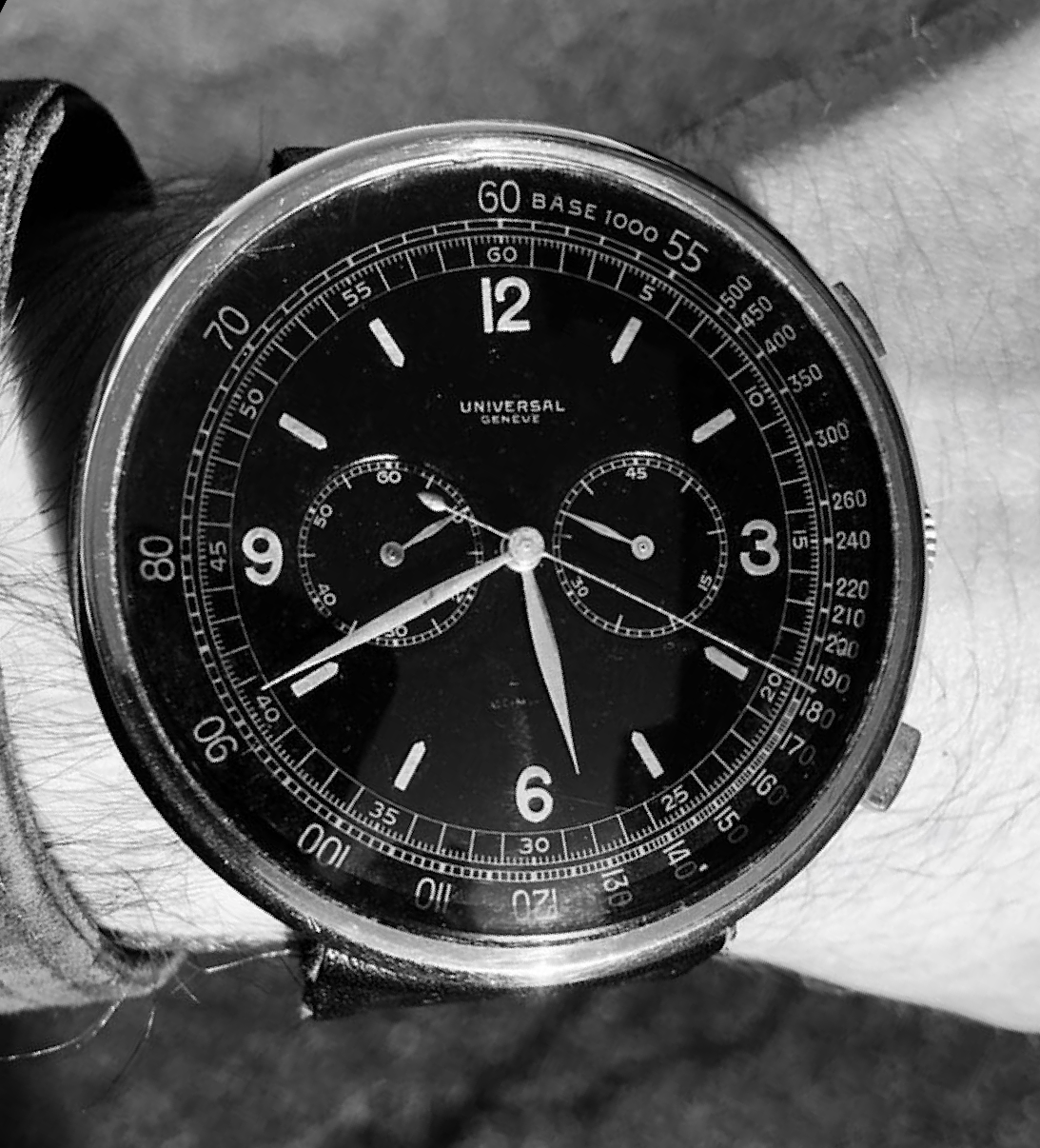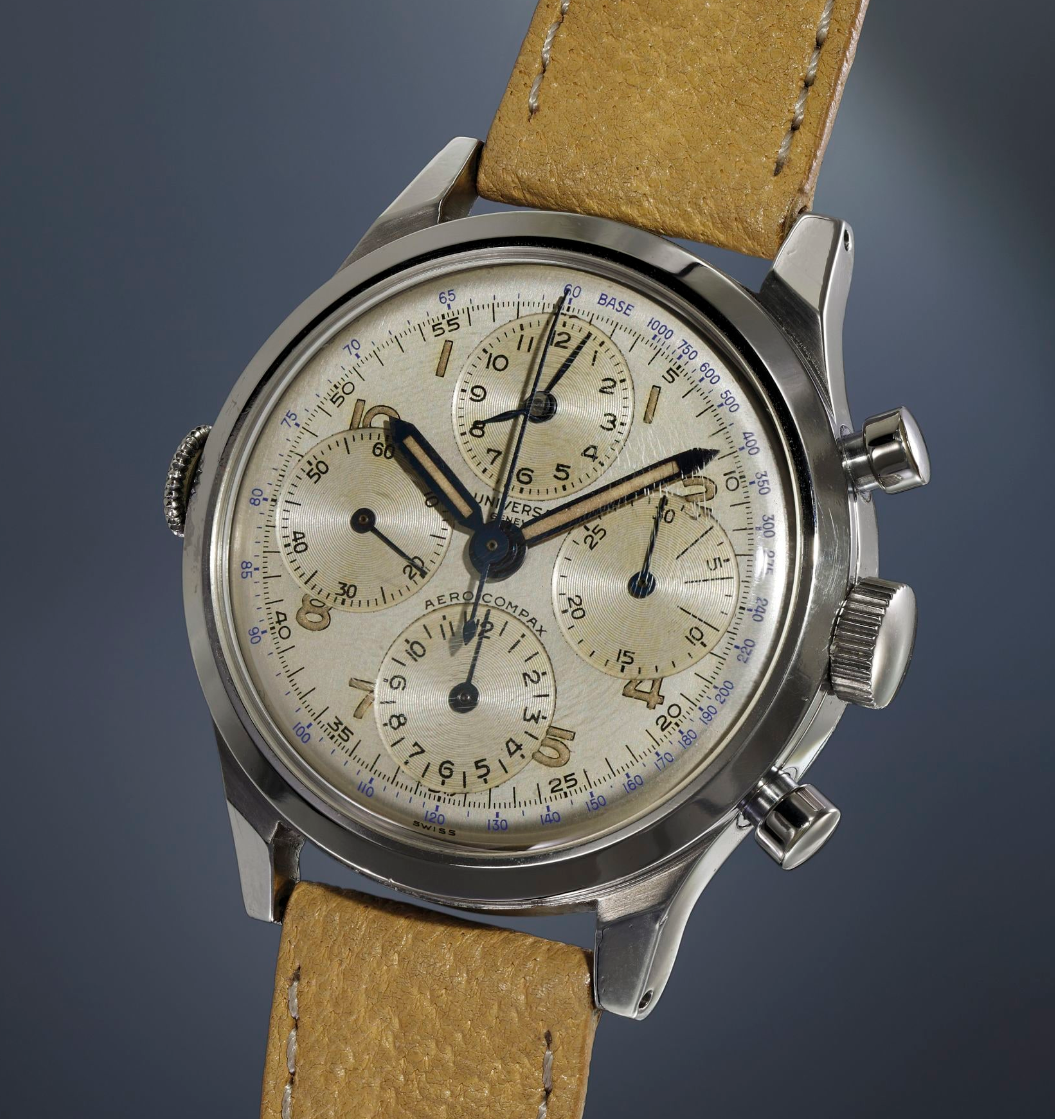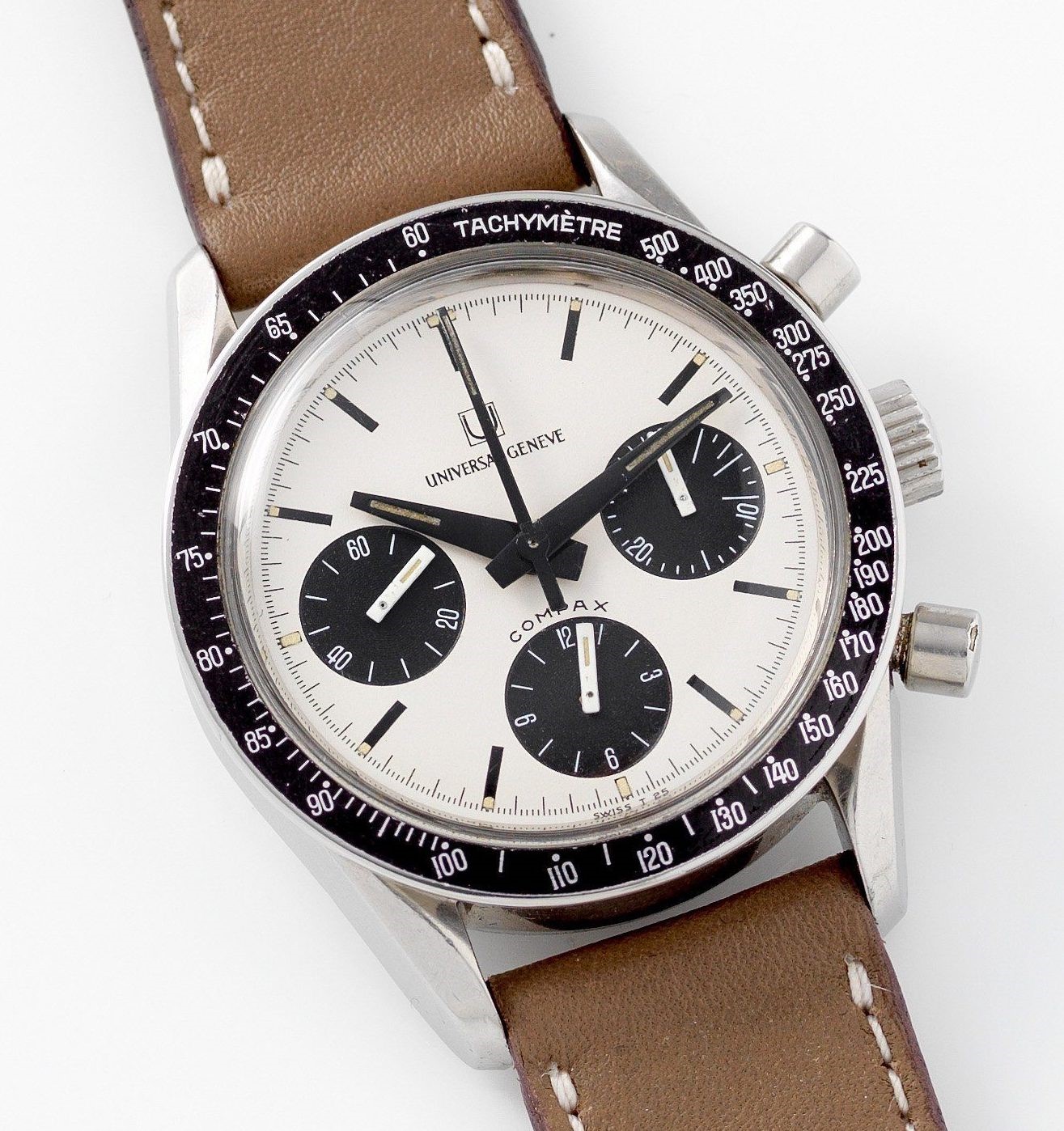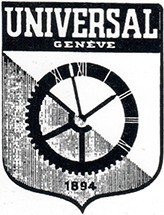Reference Coding
Throughout the years, Universal went through 3 stages of reference coding for their watch production: The earliest stage was with 4 digits followed by 5 and then 6 digit referencing. Below, you can better understand how to interpret these references, for a look at the actual watches click here:
4 Digit References: (Mid 1930s - ~1938)
| Example: Reference 7445 |
|---|
| Many of the references from this period start with 7 although it is unclear how to further interpret them. |
 |
| [Photo] By @g.barone_ |
The earliest form of reference coding is also the most mysterious. There does not seem to be an exact science regarding the digits and many watches produced in this period simply do not have a reference.
![]()
5 Digit References: (~1938 - Early 1960s)
| Example: Reference 22432 |
|---|
| We can break down the reference number in the following way: 2 - Steel Case 2 - Chronograph 4 - 285 Calibre 32 - Spillman case for Aerocompax model |
 |
| [Photo] By @Phillips |
It is not yet possible to say with exact certainty when the 5 digit referencing came into play, however from our research we have identified the transitional period to be between the 723’XXX - 727’XXX serial range, placing this change in 1938.
The 5 digit referencing is a logical and scientific approach by the brand to naming their models. It takes into account 4 variables: the case material, the complication of movement, the type of calibre and finally the case design.
| 1st Number - Case Material | |
|---|---|
| 1 | 18k Yellow/Rose Gold Case |
| 2 | Steel Case |
| 3 | Chrome Case |
| 4 | Gold Plated case |
| 5 | 14k Yellow Gold Case |
| 6 | 14k White Gold Case |
| 7 | Platinum Case |
| 2nd Number - Complication | |
|---|---|
| 0 | Time Only |
| 1 | Time Only/Calendar |
| 2 | Chronograph |
| 5 | Later Ladies Watches |
| 6 | Early Ladies Watches/Split Seconds |
| 7 | Pendant |
| 3rd Number - Calibre | |
|---|---|
| The 3rd number is mostly relative to the size of the calibre used, however it also depends on the complication of the watch. | |
| For Chronographs (x2xxx) | |
| Though on average the 3rd digit matches the following calibre type, occasional unexplainable crossovers (eg. xx2xx with 285) have been seen. | |
| 1 | 289 Cal. |
| 2 | 281, 283, 481 Cal. |
| 3 | 281, 283, 481, 483 Cal. |
| 4 | 285, 385, 386 Cal. |
| 5 | 285, 287, 292, 387 Cal. |
| For Calendars (x1xxx) | |
| 3 | 291 Cal. |
| 5 | 291 Cal. with an extension ring to fit in a larger case. |
| For Time Only (x0/1xxx) | |
| Many crossovers exist, probably because of the introduction of new calibers throughout the years. | |
| 0 | 260, 138, 138c, 139 Cal. |
| 1 | 261 Cal. |
| 2 | 262, 139, 138ss Cal. |
| 3 | 245, 215 (and other 215-x derivatives) Cal. |
| 4 | 129, 215-x, 218-x, 69 Cal. |
| 5 | 267, 218-x Cal. |
| 6 | 332 Cal. |
| 7 | 263 Cal. |
| 8 | 261 Cal. |
| 4th & 5th Number - Case Design | |
|---|---|
| The last two digits refer to the case design of the watch, in no particular logical order. In the archives you can find the same reference with a different dial but never with a different case. NB. since only 99 designs were available it is possible for this number to go above 100, for example the reference 224102. | |
![]()
6 Digit References: (Early 1960s - 1980s)
| Example: Reference 885103/02 |
|---|
| We can break down the reference number in the following way: 8 - Steel Case 85 - Cal. 85 aka Valjoux 72 103 - Model (in this case the famous Nina Rindt) /02 - White Dial variant |
 |
| [Photo] By @Bulang&Sons |
Again it is hard to pinpoint the exact date for the 5 to 6 digit transition, as no official documentation exists. However, the earliest serials recorded to have the new referencing are around the 2’3XX’XXX mark, possibly dating it to around 1962/63. This way of referencing will go on through the late 1970s. From the 1980s onwards, including the 2019 releases, we find a mix of models featuring the 6 digit references and others with a less identifiable referencing system, making it hard to apply this referencing system beyond the late 1970s production.
The interpretation of the 6 digit referencing can be broken down to the following:
| 1st Number - Case Material | |
|---|---|
| 1 | 18k Yellow Gold Case |
| 2 | 18/14k Yellow Gold |
| 3 | 14k White Gold Case |
| 4 | Gold Plated case |
| 5 | Gold Plated case |
| 8 | Steel Case |
| 2nd & 3rd Numbers - Calibre Type | |
|---|---|
| These 2 digits refer to the last 2 digits of the calibre used in said watch. Again, there are some anomalies but these seem to be the values that hold: | |
| Chronographs | |
| 81 | UG 281 Tri-Compax Cal. |
| 84 | Signed UG 125, 2 Counter based on Valjoux 23 Cal. |
| 85 | 3 Counter based on Valjoux 72 Cal. |
| 84* | 3 Counter based on Lemania 1873 Cal. |
| *Code Reused in the '90s | |
| Time Only | |
| 42 | Manual 1-42 Cal. |
| 51 | Unisonic Cal. 51 (No Date) |
| 52 | Unisonic Cal. 52 (Date) |
| 53 | Unisonic Cal. 53 (Day-Date) |
| 60 | Electric Cal. 60 (No Date) |
| 66 | Microtor Cal. 66 (No Date) |
| 67 | Microtor Cal. 67 (Date) |
| 68 | Microtor Cal. 68 (No Date) |
| 69 | Microtor Cal. 69 (Date) |
| 72 | Microtor Cal. 72 (Day-Date) |
| 4th, 5th & 6th Number - Model | |
|---|---|
| The last 3 digits of the reference are linked to the model and as of today no conclusive logical explanation can be given to the exact meaning of these numbers. | |
| /xxx Post Reference | |
|---|---|
| In this final evolution of the referencing system there seems to be a common usage of the /xx following the reference, which is often attributed to the dial type. For instance: the 881101 is the black bezel ‘Tri-Compax’, with the /01 standing for the white dial, aka the Eric Clapton, and the /02 referring to the black dial. As such, it is subjective to the reference in question, check out the Watches section for more. This holds true mainly in the early stages of the referencing system, which will later evolve to add entire model lines in the /xxxx segment such as the Golden Shadow reference 166.034/4903. | |
